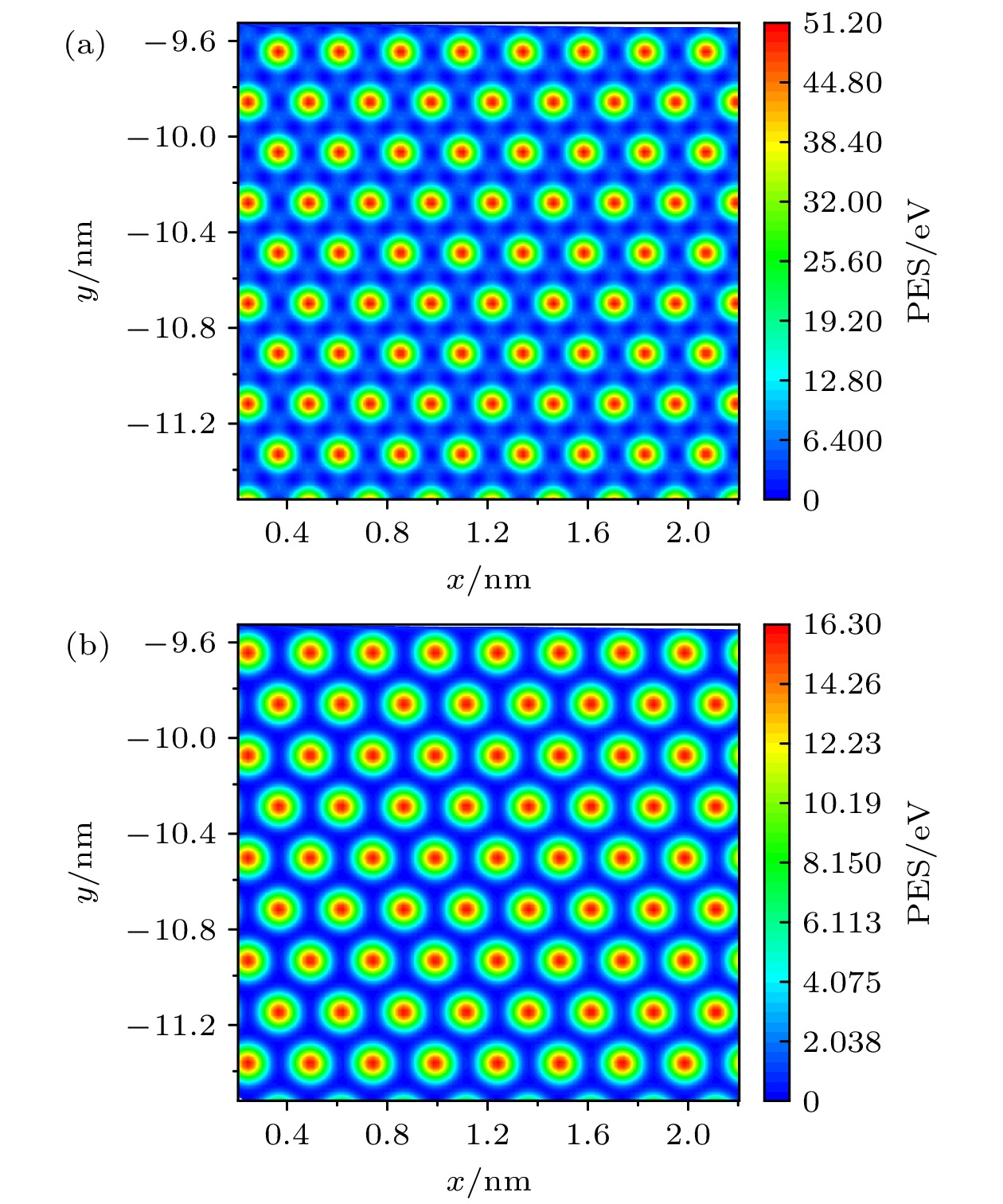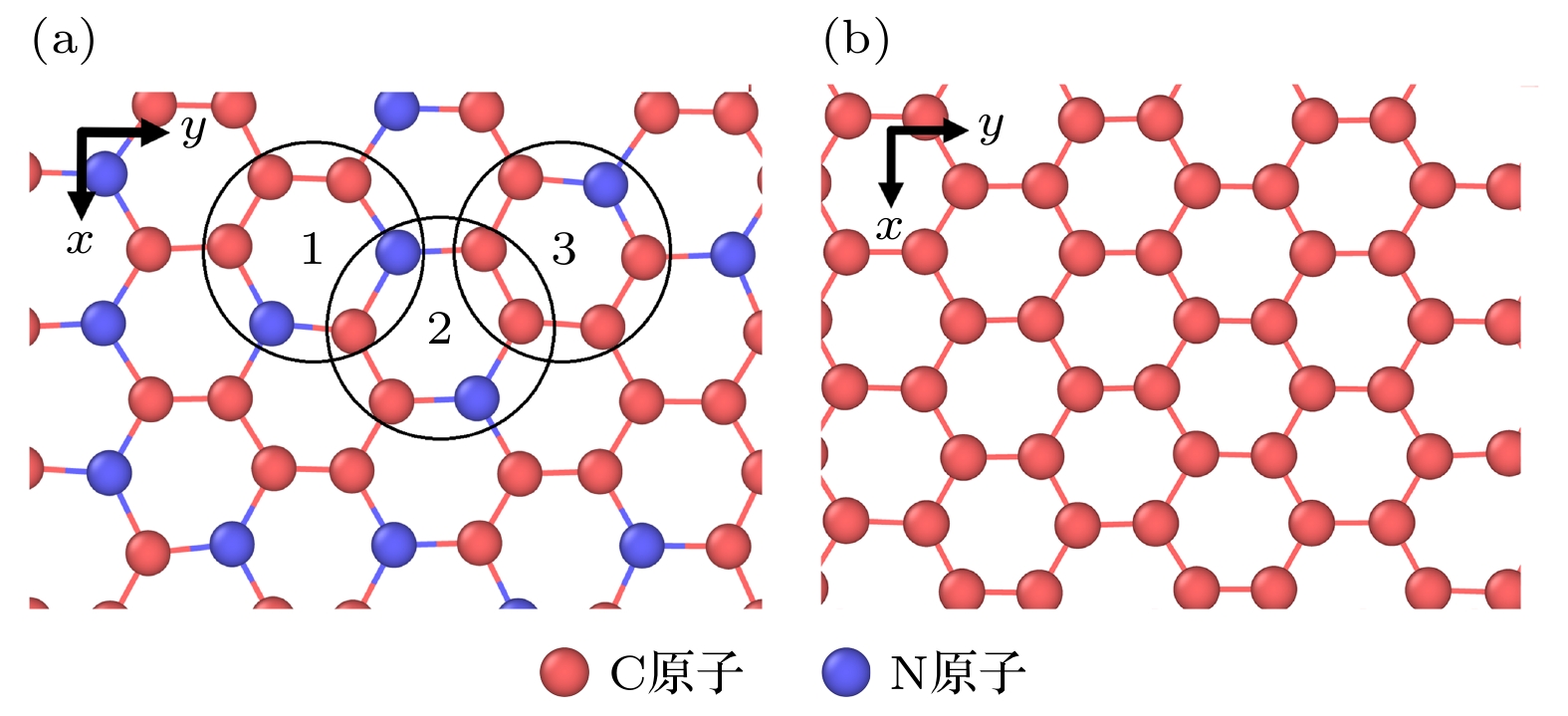-
Graphene has attracted a lot of attention due to its excellent electrical properties, however, the gapless nature of graphene limits its further applications. Doping is an effective way to open the bandgap, in which nitrogen-doped (N-doped) graphene has potential applications, but the study of its tribological properties is still lacking. In this work, the effects of nitrogen doping on the tribological properties of graphene under different interfacial structures are investigated by molecular dynamics simulation. The simulation models include a hexagonal graphene sheet, graphene or N-doped graphene substrate. The results show that the nitrogen doping has different effects on friction when interface structure is in a commensurate state and an incommensurate state. In a commensurate state, N-doping reduces the friction between interfaces in all cases, but the friction first goes up and then decreases with the increase of doping ratio of nitrogen. The local maximum value of friction occurs at a doping ratio of 7.5%. This phenomenon results from the interface structure and the change of van de Waals force between interfaces. The introduction of nitrogen atoms causes the lattice of graphene to distort, which results in the formation of local incommensurate state, thus reducing the interfacial potential barrier and friction. However, the van der Waals force between nitrogen atom and carbon atom between layers is stronger than that between carbon atoms and carbon atoms, which causes the friction to increase. When the doping ratio is low or high, lattice distortion plays more important role. The friction of N-doped graphene shows much smaller increase with load than that of ideal graphene, which indicates that the N-doped graphene possesses a better performance under high load. When the interface structure is in an incommensurate state, the introduction of nitrogen atoms shows slight influence on lattice mismatch, therefore, the change of atomic type plays a dominant role in determining the friction between interfaces, which goes up with the increase of N-doping ratio. When the substrate is graphene with vacancy defects, the value of friction between interfaces is larger than the ideal graphene substrate or N-doped graphene substrate, which indicates that the doping of nitrogen atoms has positive effect on reducing the friction of graphene with defects.
-
Keywords:
- graphene /
- N-doped /
- friction /
- molecular dynamics simulation
[1] Novoselov K S, Geim A K, Morozov S V, Jiang D, Zhang Y, Dubonos S V, Grigorieva I V, Firsov A A 2004 Science 306 666
 Google Scholar
Google Scholar
[2] Geim A K, Novoselov K S 2007 Nat. Mater. 6 183
 Google Scholar
Google Scholar
[3] Geim A K 2009 Science 324 1530
 Google Scholar
Google Scholar
[4] Martins T B, Miwa R H, da Silva A J R, Fazzio A 2007 Phys. Rev. Lett. 98 196803
 Google Scholar
Google Scholar
[5] Dutta S, Manna A K, Pati S K 2009 Phys. Rev. Lett. 102 096601
 Google Scholar
Google Scholar
[6] Biel B, Blase X, Triozon F, Roche S 2009 Phys. Rev. Lett. 102 096803
 Google Scholar
Google Scholar
[7] Kamal Kandezi M, Shadman Lakmehsari M, Matta C F 2020 J. Mol. Liq. 302 112574
 Google Scholar
Google Scholar
[8] 林婷婷, 吕秋丰 2015 功能材料 46 5007
 Google Scholar
Google Scholar
Lin T T, Lv Q F 2015 J. Func. Mater 46 5007
 Google Scholar
Google Scholar
[9] Wang G, Wang B, Wang X, Park J, Dou S, Ahn H, Kim K 2009 J. Mate. Chem. 19 8378
 Google Scholar
Google Scholar
[10] Kwon O S, Park S J, Hong J-Y, Han A R, Lee J S, Lee J S, Oh J H, Jang J 2012 ACS. Nano. 6 1486
 Google Scholar
Google Scholar
[11] Dienwiebel M, Verhoeven G S, Pradeep N, et al. 2004 Phys. Rev. Lett. 92 126101
 Google Scholar
Google Scholar
[12] Zheng X, Gao L, Yao Q, et al. 2016 Nat. Commun. 7 13204
 Google Scholar
Google Scholar
[13] Leven I, Krepel D, Shemesh O, Hod O 2013 J. Phys. Chem. Lett. 4 115
 Google Scholar
Google Scholar
[14] Liu S W, Wang H P, Xu Q, et al. 2017 Nat. Commun. 8 14029
 Google Scholar
Google Scholar
[15] 陈勇, 李瑞 2019 68 186801
 Google Scholar
Google Scholar
Chen Y, Li R 2019 Acta Phys. Sin. 68 186801
 Google Scholar
Google Scholar
[16] Wang K, Ouyang W, Cao W, Ma M, Zheng Q 2019 Nanoscale 11 2186
 Google Scholar
Google Scholar
[17] Liu Y, Grey F, Zheng Q 2014 Sci. Rep. 4 4875
 Google Scholar
Google Scholar
[18] Biswas S K 2008 Tribol Lett 30 159
 Google Scholar
Google Scholar
[19] Lee C, Li Q, Kalb W, Liu X Z, Berger H, Carpick R W, Hone J 2010 Science 328 76
 Google Scholar
Google Scholar
[20] Li S, Li Q, Carpick R W, Gumbsch P, Liu X Z, Ding X, Sun J, Li J 2016 Nature 539 541
 Google Scholar
Google Scholar
[21] Ye Z, Martini A 2014 Langmuir 30 14707
 Google Scholar
Google Scholar
[22] Guo Y, Guo W, Chen C 2007 Phys. Rev. B 76 155429
 Google Scholar
Google Scholar
[23] Dong Y, Wu X, Martini A 2013 Nanotechnology 24 375701
 Google Scholar
Google Scholar
[24] Gao L, Chen X, Yan Y, Liu Y, Song A, Ma T, Hu Y, Su Y, Qiao L 2018 Comput. Mater. Sci. 147 28
 Google Scholar
Google Scholar
[25] Li R, Song C 2018 Crystals 8 167
 Google Scholar
Google Scholar
[26] Shen Y, Wang Y, Zhou Y, Shi A, Hu J, Zhang Y 2016 J. Phys. D 49 415303
 Google Scholar
Google Scholar
[27] Stuart S J, Tutein A B, Harrison J A 2000 J. Chem. Phys. 112 6472
 Google Scholar
Google Scholar
[28] Kınacı A, Haskins J B, Sevik C, Çağın T 2012 Phys. Rev. B 86 115410
 Google Scholar
Google Scholar
[29] Lennard-Jones J E 1931 Proceed. Phys. Soc. 43 461
 Google Scholar
Google Scholar
[30] Leven I, Maaravi T, Azuri I, Kronik L, Hod O 2016 J. Chem. Theory Comput. 12 2896
 Google Scholar
Google Scholar
[31] Zhang W, Lu W C, Zhang H X, Ho K M, Wang C Z 2016 Carbon 110 330
 Google Scholar
Google Scholar
-
图 5 (a) 非公度时不同载荷下石墨烯的平均摩擦力随氮掺杂比例的变化; (b) 存在5%空位缺陷的石墨烯与N掺杂石墨烯的平均摩擦力
Figure 5. (a) Average friction on N-doped graphene with different N-doping ratio under different loads when interface is in incommensurate state; (b) average friction on graphene with 5% vacancy defects compared with N-doped graphene.
-
[1] Novoselov K S, Geim A K, Morozov S V, Jiang D, Zhang Y, Dubonos S V, Grigorieva I V, Firsov A A 2004 Science 306 666
 Google Scholar
Google Scholar
[2] Geim A K, Novoselov K S 2007 Nat. Mater. 6 183
 Google Scholar
Google Scholar
[3] Geim A K 2009 Science 324 1530
 Google Scholar
Google Scholar
[4] Martins T B, Miwa R H, da Silva A J R, Fazzio A 2007 Phys. Rev. Lett. 98 196803
 Google Scholar
Google Scholar
[5] Dutta S, Manna A K, Pati S K 2009 Phys. Rev. Lett. 102 096601
 Google Scholar
Google Scholar
[6] Biel B, Blase X, Triozon F, Roche S 2009 Phys. Rev. Lett. 102 096803
 Google Scholar
Google Scholar
[7] Kamal Kandezi M, Shadman Lakmehsari M, Matta C F 2020 J. Mol. Liq. 302 112574
 Google Scholar
Google Scholar
[8] 林婷婷, 吕秋丰 2015 功能材料 46 5007
 Google Scholar
Google Scholar
Lin T T, Lv Q F 2015 J. Func. Mater 46 5007
 Google Scholar
Google Scholar
[9] Wang G, Wang B, Wang X, Park J, Dou S, Ahn H, Kim K 2009 J. Mate. Chem. 19 8378
 Google Scholar
Google Scholar
[10] Kwon O S, Park S J, Hong J-Y, Han A R, Lee J S, Lee J S, Oh J H, Jang J 2012 ACS. Nano. 6 1486
 Google Scholar
Google Scholar
[11] Dienwiebel M, Verhoeven G S, Pradeep N, et al. 2004 Phys. Rev. Lett. 92 126101
 Google Scholar
Google Scholar
[12] Zheng X, Gao L, Yao Q, et al. 2016 Nat. Commun. 7 13204
 Google Scholar
Google Scholar
[13] Leven I, Krepel D, Shemesh O, Hod O 2013 J. Phys. Chem. Lett. 4 115
 Google Scholar
Google Scholar
[14] Liu S W, Wang H P, Xu Q, et al. 2017 Nat. Commun. 8 14029
 Google Scholar
Google Scholar
[15] 陈勇, 李瑞 2019 68 186801
 Google Scholar
Google Scholar
Chen Y, Li R 2019 Acta Phys. Sin. 68 186801
 Google Scholar
Google Scholar
[16] Wang K, Ouyang W, Cao W, Ma M, Zheng Q 2019 Nanoscale 11 2186
 Google Scholar
Google Scholar
[17] Liu Y, Grey F, Zheng Q 2014 Sci. Rep. 4 4875
 Google Scholar
Google Scholar
[18] Biswas S K 2008 Tribol Lett 30 159
 Google Scholar
Google Scholar
[19] Lee C, Li Q, Kalb W, Liu X Z, Berger H, Carpick R W, Hone J 2010 Science 328 76
 Google Scholar
Google Scholar
[20] Li S, Li Q, Carpick R W, Gumbsch P, Liu X Z, Ding X, Sun J, Li J 2016 Nature 539 541
 Google Scholar
Google Scholar
[21] Ye Z, Martini A 2014 Langmuir 30 14707
 Google Scholar
Google Scholar
[22] Guo Y, Guo W, Chen C 2007 Phys. Rev. B 76 155429
 Google Scholar
Google Scholar
[23] Dong Y, Wu X, Martini A 2013 Nanotechnology 24 375701
 Google Scholar
Google Scholar
[24] Gao L, Chen X, Yan Y, Liu Y, Song A, Ma T, Hu Y, Su Y, Qiao L 2018 Comput. Mater. Sci. 147 28
 Google Scholar
Google Scholar
[25] Li R, Song C 2018 Crystals 8 167
 Google Scholar
Google Scholar
[26] Shen Y, Wang Y, Zhou Y, Shi A, Hu J, Zhang Y 2016 J. Phys. D 49 415303
 Google Scholar
Google Scholar
[27] Stuart S J, Tutein A B, Harrison J A 2000 J. Chem. Phys. 112 6472
 Google Scholar
Google Scholar
[28] Kınacı A, Haskins J B, Sevik C, Çağın T 2012 Phys. Rev. B 86 115410
 Google Scholar
Google Scholar
[29] Lennard-Jones J E 1931 Proceed. Phys. Soc. 43 461
 Google Scholar
Google Scholar
[30] Leven I, Maaravi T, Azuri I, Kronik L, Hod O 2016 J. Chem. Theory Comput. 12 2896
 Google Scholar
Google Scholar
[31] Zhang W, Lu W C, Zhang H X, Ho K M, Wang C Z 2016 Carbon 110 330
 Google Scholar
Google Scholar
Catalog
Metrics
- Abstract views: 7056
- PDF Downloads: 146
- Cited By: 0















 DownLoad:
DownLoad:





